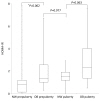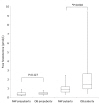Ann Pediatr Endocrinol Metab.
2016 Dec;21(4):219-225. 10.6065/apem.2016.21.4.219.
The impact of obesity on hyperandrogenemia in Korean girls
- Affiliations
-
- 1Department of Pediatrics, Hallym University Sacred Heart Hospital, Anyang-si, Korea.
- 2Department of Pediatrics, Kangdong Sacred Heart Hospital, Seoul, Korea. ithwang83@hallym.or.kr
- KMID: 2366813
- DOI: http://doi.org/10.6065/apem.2016.21.4.219
Abstract
- PURPOSE
As metabolic complication and polycystic ovarian syndrome due to childhood obesity is rising, the role of hyperandrogenemia (HA) and hyperinsulinism is receiving attention. The aims of this study were to investigate the presence of obvious HA according to pubertal status and to find potential etiologic determinants of HA in Korean obese (OB) girls.
METHODS
We analyzed 91 girls aged 6-17 years (prepuberty, n=54; puberty, n=37). Each girl was classified as being either normal weight (NW) or OB. Anthropometric measurements were obtained and blood test was performed early in the morning after at least 8 hours of fasting to measure glucose, insulin, total testosterone, sex hormone-binding globulin, dehydroepiandrosterone sulfate (DHEAS), luteinizing hormone (LH), follicular-stimulating hormone, estradiol, and progesterone.
RESULTS
The plasma levels of free testosterone (FT) and DHEAS were markedly higher in OB girls compared to NW girls in puberty (FT, P=0.009; DHEAS, P=0.046) but not in prepuberty (FT, P=0.183; DHEAS, P=0.052). Hyperinsulinemia and high homeostasis model assessment of insulin resistance (HOMA-IR) values were found regardless of pubertal status in OB girls. The significant related factor to HA in puberty was the body mass index Z-score (P=0.003). But HOMA-IR, LH, and progesterone levels were not relevant to HA in pubertal girls.
CONCLUSION
OB prepubertal girls did not show HA in the present study but they should be regularly monitored because they already had hyperinsulinemia. OB pubertal girls had significant HA and hyperinsulinemia, and obesity per se was the most important factor for HA.
Keyword
Figure
Reference
-
1. Kim KE, Kim SH, Park S, Khang YH, Park MJ. Changes in prevalence of obesity and underweight among Korean children and adolescents: 1998-2008. Korean J Obes. 2012; 21:228–235.
Article2. Yang S, Hwang JS, Park HK, Lee HS, Kim HS, Kim EY, et al. Serum lipid concentrations, prevalence of dyslipidemia, and percentage eligible for pharmacological treatment of Korean children and adolescents; data from the Korea National Health and Nutrition Examination Survey IV (2007-2009). PLoS One. 2012; 7:e49253. PMID: 23251338.
Article3. Anderson AD, Solorzano CM, McCartney CR. Childhood obesity and its impact on the development of adolescent PCOS. Semin Reprod Med. 2014; 32:202–213. PMID: 24715515.
Article4. Vilmann LS, Thisted E, Baker JL, Holm JC. Development of obesity and polycystic ovary syndrome in adolescents. Horm Res Paediatr. 2012; 78:269–278. PMID: 23208318.
Article5. Stanley T, Misra M. Polycystic ovary syndrome in obese adolescents. Curr Opin Endocrinol Diabetes Obes. 2008; 15:30–36. PMID: 18185060.
Article6. Burt Solorzano CM, McCartney CR, Blank SK, Knudsen KL, Marshall JC. Hyperandrogenaemia in adolescent girls: origins of abnormal gonadotropin-releasing hormone secretion. BJOG. 2010; 117:143–149. PMID: 20002394.
Article7. Ibáñez L, Ong KK, López-Bermejo A, Dunger DB, de Zegher F. Hyperinsulinaemic androgen excess in adolescent girls. Nat Rev Endocrinol. 2014; 10:499–508. PMID: 24776733.
Article8. Azziz R, Carmina E, Dewailly D, Diamanti-Kandarakis E, Escobar-Morreale HF, Futterweit W, et al. Positions statement: criteria for defining polycystic ovary syndrome as a predominantly hyperandrogenic syndrome: an Androgen Excess Society guideline. J Clin Endocrinol Metab. 2006; 91:4237–4245. PMID: 16940456.
Article9. Pasquali R, Stener-Victorin E, Yildiz BO, Duleba AJ, Hoeger K, Mason H, et al. PCOS Forum: research in polycystic ovary syndrome today and tomorrow. Clin Endocrinol (Oxf). 2011; 74:424–433. PMID: 21158892.
Article10. Franks S. Adult polycystic ovary syndrome begins in childhood. Best Pract Res Clin Endocrinol Metab. 2002; 16:263–272. PMID: 12064892.
Article11. McCartney CR, Prendergast KA, Chhabra S, Eagleson CA, Yoo R, Chang RJ, et al. The association of obesity and hyperandrogenemia during the pubertal transition in girls: obesity as a potential factor in the genesis of postpubertal hyperandrogenism. J Clin Endocrinol Metab. 2006; 91:1714–1722. PMID: 16492701.
Article12. McCartney CR, Blank SK, Prendergast KA, Chhabra S, Eagleson CA, Helm KD, et al. Obesity and sex steroid changes across puberty: evidence for marked hyperandrogenemia in pre- and early pubertal obese girls. J Clin Endocrinol Metab. 2007; 92:430–436. PMID: 17118995.
Article13. McCartney CR, Prendergast KA, Blank SK, Helm KD, Chhabra S, Marshall JC. Maturation of luteinizing hormone (gonadotropin-releasing hormone) secretion across puberty: evidence for altered regulation in obese peripubertal girls. J Clin Endocrinol Metab. 2009; 94:56–66. PMID: 18957503.
Article14. Knudsen KL, Blank SK, Burt Solorzano C, Patrie JT, Chang RJ, Caprio S, et al. Hyperandrogenemia in obese peripubertal girls: correlates and potential etiological determinants. Obesity (Silver Spring). 2010; 18:2118–2124. PMID: 20339367.
Article15. Burt Solorzano CM, McCartney CR. Obesity and the pubertal transition in girls and boys. Reproduction. 2010; 140:399–410. PMID: 20802107.
Article16. Reinehr T, de Sousa G, Roth CL, Andler W. Androgens before and after weight loss in obese children. J Clin Endocrinol Metab. 2005; 90:5588–5595. PMID: 16014405.
Article17. Cara JF, Rosenfield RL. Insulin-like growth factor I and insulin potentiate luteinizing hormone-induced androgen synthesis by rat ovarian thecal-interstitial cells. Endocrinology. 1988; 123:733–739. PMID: 2969325.
Article18. Moghetti P, Castello R, Negri C, Tosi F, Spiazzi GG, Brun E, et al. Insulin infusion amplifies 17 alpha-hydroxycorticosteroid intermediates response to adrenocorticotropin in hyperandrogenic women: apparent relative impairment of 17,20-lyase activity. J Clin Endocrinol Metab. 1996; 81:881–886. PMID: 8772544.
Article19. Nestler JE, Jakubowicz DJ, de Vargas AF, Brik C, Quintero N, Medina F. Insulin stimulates testosterone biosynthesis by human thecal cells from women with polycystic ovary syndrome by activating its own receptor and using inositolglycan mediators as the signal transduction system. J Clin Endocrinol Metab. 1998; 83:2001–2005. PMID: 9626131.
Article20. Ng M, Fleming T, Robinson M, Thomson B, Graetz N, Margono C, et al. Global, regional, and national prevalence of overweight and obesity in children and adults during 1980-2013: a systematic analysis for the Global Burden of Disease Study 2013. Lancet. 2014; 384:766–781. PMID: 24880830.21. Korea Centers for Disease Control and Prevention, Division of Chronic Disease Surveillance, Committee for the Development of Growth Standard for Korean Children and Adolescents. Korean Pediatric Society, Committee for School Health and Public Health Statistics. 2007 Korean children and adolescents growth standard (commentary for the development of 2007 growth chart). Cheongju: Korea Centers for Disease Control and Prevention, Division of Chronic Disease Surveillance;2007.22. Vermeulen A, Verdonck L, Kaufman JM. A critical evaluation of simple methods for the estimation of free testosterone in serum. J Clin Endocrinol Metab. 1999; 84:3666–3672. PMID: 10523012.
Article23. Matthews DR, Hosker JP, Rudenski AS, Naylor BA, Treacher DF, Turner RC. Homeostasis model assessment: insulin resistance and beta-cell function from fasting plasma glucose and insulin concentrations in man. Diabetologia. 1985; 28:412–419. PMID: 3899825.
Article25. Dieudonne MN, Pecquery R, Boumediene A, Leneveu MC, Giudicelli Y. Androgen receptors in human preadipocytes and adipocytes: regional specificities and regulation by sex steroids. Am J Physiol. 1998; 274(6 Pt 1):C1645–C1652. PMID: 9611130.26. Kershaw EE, Flier JS. Adipose tissue as an endocrine organ. J Clin Endocrinol Metab. 2004; 89:2548–2556. PMID: 15181022.
Article27. Pugeat M, Crave JC, Elmidani M, Nicolas MH, Garoscio-Cholet M, Lejeune H, et al. Pathophysiology of sex hormone binding globulin (SHBG): relation to insulin. J Steroid Biochem Mol Biol. 1991; 40:841–849. PMID: 1958579.
Article28. Soldani R, Cagnacci A, Yen SS. Insulin, insulin-like growth factor I (IGF-I) and IGF-II enhance basal and gonadotrophin-releasing hormone-stimulated luteinizing hormone release from rat anterior pituitary cells in vitro. Eur J Endocrinol. 1994; 131:641–645. PMID: 7804448.
Article29. Rosenfield RL, Bordini B. Evidence that obesity and androgens have independent and opposing effects on gonadotropin production from puberty to maturity. Brain Res. 2010; 1364:186–197. PMID: 20816944.
Article30. Wang Y. Is obesity associated with early sexual maturation? A comparison of the association in American boys versus girls. Pediatrics. 2002; 110:903–910. PMID: 12415028.
Article31. Ahmed ML, Ong KK, Dunger DB. Childhood obesity and the timing of puberty. Trends Endocrinol Metab. 2009; 20:237–242. PMID: 19541497.
Article32. Pastor CL, Griffin-Korf ML, Aloi JA, Evans WS, Marshall JC. Polycystic ovary syndrome: evidence for reduced sensitivity of the gonadotropin-releasing hormone pulse generator to inhibition by estradiol and progesterone. J Clin Endocrinol Metab. 1998; 83:582–590. PMID: 9467578.
Article33. Travers SH, Jeffers BW, Bloch CA, Hill JO, Eckel RH. Gender and Tanner stage differences in body composition and insulin sensitivity in early pubertal children. J Clin Endocrinol Metab. 1995; 80:172–178. PMID: 7829608.
Article
- Full Text Links
- Actions
-
Cited
- CITED
-
- Close
- Share
- Similar articles
-
- Statistical analysis of the prevalence and trend of obesity in elementary school children in Kwangju
- Does coronavirus disease 2019 affect body mass index of children and adolescents who visited a growth clinic in South Korea?: a single-center study
- The Long-term Follow-up Studies of Childhood Obesity after Puberty
- Dietary patterns of obese high school girls: snack consumption and energy intake
- Comparison of Obesity and Growth Development in Menarcheal and Nonmenarcheal Girls



